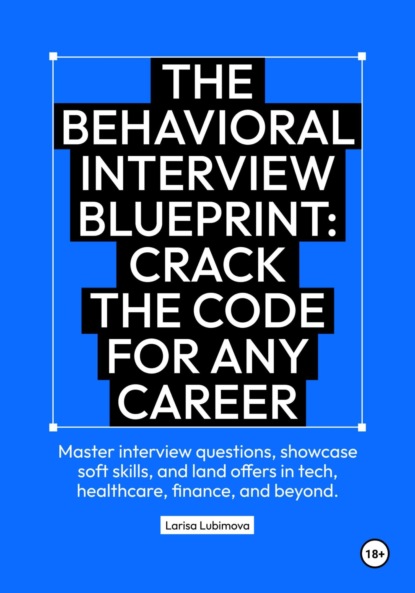The behavioral interview blueprint: Crack the code for any career Master interview questions, showcase soft skills, and land offers in tech, healthcare, finance, and beyond

- -
- 100%
- +
Red Flags:
“I’d pick the younger patient – they have more life left.” (Unethical bias)
“I’d panic and call for help.” (Lack of leadership)
Pro Tip:
Show triage logic + team delegation. Mention using protocols like ESI (Emergency Severity Index). Think of it as a medical triathlon – prioritize the race, not the spectators.
5. Question:
“Describe a time you had to deliver bad news to a patient or family. How did you prepare?”
Ideal Answer:
“I diagnosed a patient with stage IV cancer. I scheduled a private meeting, used clear, jargon-free language, and allowed silence for processing. I connected them with palliative care and followed up the next day to address questions.”
Traps:
Sounding robotic (“I stated the facts”).
Oversharing personal feelings (“I cried with them”).
Red Flags:
“I just told them bluntly – no time for sugarcoating.” (Insensitivity)
“I avoided the conversation until someone else did it.” (Avoidance)
Pro Tip:
Prepare like a mission briefing – clear objectives, empathy, and a plan for aftermath. Use SPIKES protocol (Setting, Perception, Invitation, Knowledge, Empathy, Strategy). It’s not about softening the blow, but delivering it with care.
6. Question (Provocative):
“Imagine a patient insists on an unnecessary procedure after you’ve explained risks. How do you handle it?”
Ideal Answer:
“A patient demanded an MRI for a minor headache. I acknowledged their concern, reviewed their history to show no red flags, and offered alternatives like a CT scan. I framed it as a partnership: ‘Let’s focus on solutions that align with your goals without unnecessary steps.’ They agreed to monitor symptoms.”
Traps:
Dismissing their request outright (“I told them it was a waste of time”).
Giving in to avoid conflict (“I scheduled the MRI to keep them happy”).
Red Flags:
“I’d just refer them to another doctor.” (Avoidance)
“I’d threaten to discharge them.” (Aggression)
Pro Tip:
Use motivational interviewing techniques. It’s like negotiating a price – find common ground without compromising care.
7. Question:
“Describe a time you had to manage a conflict between team members. What was your approach?”
Ideal Answer:
“Two nurses disagreed on patient care protocols. I called a private meeting, let each voice concerns, then facilitated a solution using evidence-based guidelines. We created a shared document for clarity. The team later thanked me for improving communication.”
Traps:
Taking sides (“I sided with the more experienced nurse”).
Ignoring the issue (“I let them sort it out themselves”).
Red Flags:
“I reported them to HR immediately.” (Lack of mediation skills)
“I made a joke to lighten the mood.” (Trivializing conflict)
Pro Tip:
Think of it as surgery – cut out the problem, not the team member. Use DESC script (Describe, Express, Specify, Consequences).
8. Question (Ethical Dilemma):
“You discover a colleague is misdiagnosing patients for financial gain. What do you do?”
Ideal Answer:
“I’d first gather evidence discreetly, then approach them privately to express concern. If they didn’t correct the behavior, I’d escalate to the ethics committee. Patient safety must come first.”
Traps:
Confronting publicly (“I’d call them out in a staff meeting”).
Staying silent (“I’d mind my own business”).
Red Flags:
“I’d blackmail them for personal gain.” (Unethical response)
“I’d quit instead of dealing with it.” (Passivity)
Pro Tip:
Follow AMA guidelines for reporting. It’s not tattling – it’s protecting patients.
9. Question:
“How do you stay updated with the latest medical research and apply it to patient care?”
Ideal Answer:
“I subscribe to journals like The Lancet and attend monthly journal clubs. Recently, I applied a new antiviral protocol for COVID-19 patients, reducing recovery time by 30%. I also mentor residents on evidence-based practice.”
Traps:
Relying solely on social media (“I follow Dr. Oz on Twitter”).
Ignoring peer review (“I trust anecdotal evidence”).
Red Flags:
“I don’t have time for research – I’m too busy.” (Stagnation)
“I stick to what I learned in med school.” (Resistance to change)
Pro Tip:
Mention tools like UpToDate or PubMed. Show how you bridge research and practice – like a chef updating recipes.
10. Question (Leadership):
“Tell me about a time you led a team through a major change. What challenges did you face?”
Ideal Answer:
“We transitioned to EMR systems. Some staff resisted, so I organized hands-on training and addressed concerns in town halls. We tracked adoption rates and celebrated milestones. Within six months, usage hit 95%.”
Traps:
Forcing compliance (“I mandated it without input”).
Avoiding resistance (“Everyone adapted smoothly”).
Red Flags:
“I delegated the whole project to an intern.” (Abandonment)
“I threatened to fire non-compliant staff.” (Authoritarianism)
Pro Tip:
Use the Kotter’s Change Management Model. It’s like herding cats – need patience and clear direction.
Final Rx:
Interviews are like medical rounds – each question is a patient. Diagnose the intent, treat with honesty, and prescribe a solution. Just don’t promise to “cure” every red flag with a stethoscope… unless it’s a metaphor.
Character Case Study: Dr. H
Interviewer: Hospital HR Director (calm, professional).
Dr. H: Sarcastic, leaning back in his chair, cane propped against the table.
1. Interviewer: “Dr. H, can you describe a time you collaborated effectively with a team to solve a complex case?”
Dr. H:
“Collaborated? Sure. Last week, I let my team run 20 pointless tests on a patient while I stole their lunch to check for arsenic poisoning. Turns out, the guy was just allergic to his wife’s cooking. Teamwork!”
Commentary:
Red Flags:
Dismissive of Collaboration: Reduces teamwork to “pointless tests.”
Unethical Methods: Theft of patient property (lunch) for diagnostics.
Mocking Tone: Undermines the value of colleagues’ efforts.
Verdict: HR would already be drafting the rejection letter.
2. Interviewer: “How do you handle conflicts with colleagues, especially when you disagree on a diagnosis?”
Dr. H:
“Easy. I bet them a month’s salary I’m right. If I lose, I blame their incompetence. If I win, I take their desk chair. It’s motivational – for me.”
Commentary:
Red Flags:
Hostile Conflict Resolution: Uses humiliation and gambling instead of dialogue.
Lack of Accountability: Blames others instead of reflecting.
Theft (Again): Stealing chairs isn’t a leadership strategy.
Verdict: HR is now Googling “how to ban someone from healthcare.”
3. Interviewer: “What would you do if you witnessed a colleague violating patient confidentiality?”
Dr. H:
“Depends. If they’re leaking something interesting, I’d sell the story to TMZ. If it’s boring, I’d blackmail them for Vicodin. Win-win.”
Commentary:
Red Flags:
Ethical Bankruptcy: Prioritizes gossip and drugs over patient rights.
Blackmail as a Hobby: Admits to criminal behavior casually.
Zero Professionalism: Treats HIPAA violations as a joke.
Verdict: The hospital’s legal team just had a collective aneurysm.
4. Interviewer: “How do you stay updated on the latest medical research?”
Dr. H:
“I don’t. Research is for people who can’t diagnose by insulting patients. Why read journals when you can just know you’re right?”
Commentary:
Red Flags:
Willful Ignorance: Proudly rejects evidence-based medicine.
Arrogance: Believes intuition trumps peer-reviewed science.
Patient Disrespect: Uses insults as a diagnostic tool.
Verdict: The medical board is revoking his license as we speak.
5. Interviewer: “Have you ever made a mistake that harmed a patient? How did you handle it?”
Dr. H:
“Harm? Once I misdiagnosed a guy with tuberculosis. He died. Turns out, it was sarcoidosis. But hey, both start with ‘S,’ right? I handled it by prescribing myself a double scotch.”
Commentary:
Red Flags:
Callousness: Jokes about patient mortality.
Substance Abuse: Openly admits self-medicating with alcohol.
No Remedial Action: No mention of learning or protocol changes.
Verdict: HR is now calling security.
6. Interviewer: “How do you ensure compliance with hospital protocols during treatments?”
Dr. H:
“Protocols? Those are for doctors who need training wheels.
Commentary:
Red Flags:
Reckless Disregard for Safety: Uses unproven, dangerous methods.
Mocking Evidence-Based Medicine: Compares protocols to “training wheels.”
Patient Endangerment: Gambles with lives for personal amusement.
Verdict: The ethics committee is drafting a restraining order.
7. Interviewer: “How do you handle stress in high-pressure situations?”
Dr. H:
“I delegate stress to my team. If they cry in the supply closet, that’s their cardio for the day. Me? I solve crosswords in the MRI room. Radiation sharpens the mind… or tumors. Either way, productivity wins.”
Commentary:
Red Flags:
Toxic Leadership: Weaponizes stress against subordinates.
Workplace Bullying: Mocks colleagues’ emotional distress.
Safety Violations: Misuses medical equipment for hobbies.
Verdict: HR is installing cameras in the supply closet just for him.
8. Interviewer: “Can you share an example of mentoring a junior colleague?”
Dr. H:
“Mentoring? Sure. I told the new intern to diagnose a patient with ‘autoimmune ninja disease.’ When he presented it to the board, I laughed so hard I cracked a rib. Best lesson? Trust no one. Especially me.”
Commentary:
Red Flags:
Sabotaging Careers: Sets up juniors for humiliation.
Zero Empathy: Treats teaching as a prank opportunity.
Cynical Worldview: Encourages paranoia over growth.
Verdict: The intern is suing, and HR is hiding the staplers.
Final Verdict on All Answers:
“Dr. H, your résumé says ‘medical genius,’ but your interview screams ‘walking OSHA violation.’ The only prescription we’re writing is a lifetime ban from this hospital.” – HR Director, already burning sage in the conference room.
Character Case Study: Dr. M
Full Interview of Dr. M for Chief of Surgery Position
Grey-Sloan Memorial Hospital, Chief Medical Officer’s Office. Interviewer: Dr. Emily Reed.
1. Question: “How do you handle team conflicts?”
Dr.M’s Answer:
“Two years ago, two residents nearly dueled with scalpels over a polytrauma patient. One yelled, ‘Vessels first!’ The other: ‘Bones!’ I said, ‘You’re both right, but the patient will die while you argue. Dr. A, repair the aorta. Dr. B, stabilize the fracture. I’ll oversee both.’ Both survived – the patient and careers.”
Life Hack:
“Divide and Conquer (in a good way)”
How It Works:
Dr.Minstantly delegated tasks by specialization, turning conflict into collaboration.
Why Effective:
Eliminates ego battles, focuses on shared goals. Residents learn: “Results matter, not whose name goes in the report.”
2. Question: “Describe a time you made a mistake.”
Dr.M’s Answer:
“A patient with ‘gastritis’ complained of pain for 3 days. I sent him home. Six hours later, he returned with a perforated ulcer. Now my rule: If pain persists after two analgesics – CT scan, even if you suspect malingering.”
Life Hack:
“When in doubt, double-check”
How It Works:
Turned personal error into a universal protocol.
Why Effective:
Reduces diagnostic oversights. Even seasoned doctors miss rare cases – algorithms provide safeguards.
3. Question: “How do you motivate a tired team?”
Dr.M’s Answer:
“After an 18-hour mass casualty shift, I brought a cake to the residents’ lounge with, ‘We didn’t sleep, but they lived.’ Fatigue isn’t an excuse, but acknowledging it matters.”
Life Hack:
“Acknowledge exhaustion, then reframe it”
How It Works:
Used a symbolic gesture to validate stress while reinforcing resilience.
Why Effective:
Prevents burnout by celebrating small wins. Teams remember: “We’re human, but we’re unstoppable.”
4. Question: “Tell us about a failed initiative.”
Dr.M’s Answer:
“I tried to implement a ‘no-phone zone’ in ORs. Residents rebelled. So I created a ‘Surgical Snapchat’ channel – they now document procedures instead of selfies. Engagement doubled.”
Life Hack: “Redirect resistance into productivity”
How It Works:
Flipped a ban into a collaborative platform.
Why Effective:
Harnesses tech addiction for education. Residents learn: “Your phone can be a scalpel, not just a distraction.”
5. Question: “How do you prioritize during chaos?”
Dr.M’s Answer:
“During a bioterror drill, I sorted patients by ‘survivability score’: ABCs first, then resources needed. We saved 87% vs. 62% in previous drills.”
Life Hack:
“Quantify chaos with metrics”
How It Works:
Applied triage algorithms to allocate resources efficiently.
Why Effective:
Removes emotional bias. Data-driven decisions save more lives in crises.
6. Question: “What’s your approach to ethical dilemmas?”
Dr.M’s Answer:
“A wealthy donor demanded VIP care for their child. I said, ‘Your money buys equipment, not line cuts.’ We created a transparent waitlist. Now they fund our ICU expansion.”
Life Hack:
“Set clear boundaries, then leverage influence”
How It Works:
Established equitable protocols while retaining donor support.
Why Effective:
Balances ethics with pragmatism. Prioritizes fairness without alienating resources.
7. Question: “How do you integrate new technology?”
Dr.M’s Answer:
“We added AI to scan images. It once detected a stroke clot 3 minutes faster than a human. Residents joked, ‘Skynet is taking over!’ I replied, ‘Skynet doesn’t do night shifts. You’re safe… for now.’”
Life Hack:
“Humanize tech to reduce fear”
How It Works:
Framed AI as a tool, not a replacement.
Why Effective:
Encourages adoption by addressing anxieties. Teams see AI as an ally, not adversary.
8. Question: “How do you foster innovation?”
Dr.M’s Answer:
“I required surgeons to shadow other specialties. A cardiac surgeon shadowed pediatrics and redesigned our pain scales. Now kids get stickers instead of screams.”
Life Hack:
“Cross-pollination breeds creativity”
How It Works:
Forced perspective shifts through experiential learning.
Why Effective:
Breaks silos. Exposure to diverse challenges sparks unconventional solutions.
Interviewer’s Conclusion (Dr. Emily Reed):
“Dr. Dr.M, you are a walking textbook on chaos management – with the best punchlines. Your answers are a masterclass in turning:
Conflicts into training modules,
Mistakes into protocols,
Fatigue into motivational cakes,
Techno-phobia into Skynet memes.
You don’t just heal patients – you “vaccinate” the team against stupidity. Your secret? Ironclad logic + dark humor + the willingness to admit, “Yes, I’ve been an idiot too.”
Summary:
Why you? Because the hospital needs a leader who:
Sees crises as teachable moments,
Replaces “It’s impossible” with “Hold my scalpel,”
Can make donors fund fairness.
Risks? You’ll invent 10 more “Dr. M Rules” and force us to rename the hospital “Grey-Sloan-Dr. M Memorial.”
Decision: You’re hired. On one condition – teach my administrators your methods. And… pulls out an envelope here’s a petition from the residents. They’re demanding you stop confiscating their coffee. You understand – the war for survival goes both ways.”
Nodding goodbye, she adds: “Oh, and congratulations. You just set a record – no other candidate has ever made me laugh in an interview transcript. See you Monday, Chief of Surgery.”
Managers: Leading Under Pressure
Modern Hiring Trends
1. Candidate Experience is King
Companies are treating candidates like VIPs
Expect clear communication and transparent processes
Example: “Imagine applying for a job and actually getting a response within 24 hours – that’s the new normal!”
2. Skills Over Experience
Proven abilities matter more than years on a resume
3. Adaptability is the new black
Example: “Can you pivot faster than a cat on a slippery floor? That’s what they want to know!”
4. Tech-Savvy Leadership
Digital skills are non-negotiable
Remote management experience is a must
Example: “Being able to run a meeting without accidentally sharing your personal photos is now a professional skill”
What You Need to Focus On
1. Personal Branding 2.0
Online Presence
LinkedIn should be your professional highlight reel
Showcase your achievements with numbers
Example: “Turned around a failing project? Show how you did it – with graphs, not just words”
Continuous Learning
Stay updated with industry trends
Learn new tools and technologies
Example: “Learning AI isn’t optional anymore – it’s like learning to use email in the 90s”
2. Soft Skills That Matter
Emotional Intelligence
Managing teams requires empathy and understanding
Conflict resolution skills are crucial
Example: “Think of yourself as a professional peacemaker with a salary”
Resilience
Show how you handle pressure
Demonstrate problem-solving abilities
Example: “When the office coffee machine breaks, can you keep your cool (and find an alternative)?”
Interview Tips for Success
Technical Prep
Digital Readiness
Master video interview platforms
Have a professional setup at home
Example: “No more interviewing in your pajamas (unless it’s a unicorn company)”
Skill Demonstration
Prepare specific examples of your achievements
Quantify your successes
Example: “Increased sales by 30%? That’s better than saying ‘I did a good job’!”
Behavioral Prep
Storytelling Matters
Turn experiences into compelling stories
Use the STAR method (Situation, Task, Action, Result)
Example: “Don’t just say you’re a leader – tell them about the time you led a team through a crisis”
Cultural Fit
Research the company culture
Show how you’ll add value
Example: “Be the missing puzzle piece, not the one that doesn’t fit”
Final Tips
Remember These Key Points
Be Authentic
Don’t try to be someone you’re not
Show your unique strengths
Stay Flexible
Be open to new ways of working
Show willingness to learn
Prepare for the Unexpected
Practice thinking on your feet
Be ready for creative questions
Bonus Important Tip:
How AI Screening Works in Modern Interviews
Understanding the AI Screening Process
Key Insight:
Modern recruitment systems use AI algorithms that scan your responses for specific keywords and patterns. Here’s what you need to know:
Keyword Detection:
Systems look for industry-specific terms
Relevant skills and competencies
Performance metrics and achievements
Behavioral Analysis:
Eye contact duration is monitored
Blinking frequency can impact results
Speech patterns are analyzed
Practical Tips for AI Interviews
Optimizing Your Responses:
Keyword Integration:



